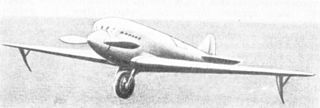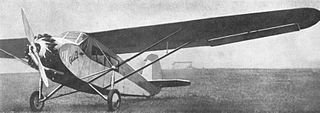Related Research Articles
The Nikitin-Schyevchyenko IS series, were single seat polymorphic fighters designed and produced in the USSR from 1938.
The Belyayev Babochka was a tandem seat research aircraft designed in the USSR in 1939.
The DB-LK was a bomber aircraft designed and built in the USSR in 1939.
The SK-1,, was a research aircraft designed and built in the USSR from 1938.

The SK-2, was a fighter aircraft designed and built in the USSR from 1940.

The DAR, was a twin-engined flying boat designed and produced in the USSR from 1934.

The Bartini Stal-6, was a single-engined experimental aircraft designed, built and tested in the USSR from 1930.
The Tairov OKO-1, was a passenger transport aircraft produced in the Ukrainian SSR in the USSR in 1937.
The ARK-Z-1, was a single-engined transport aircraft designed and produced in the USSR from 1933.

The Stal-2 was a Russian mid-range passenger aircraft.
The Stal-3 was a transport aircraft designed and built in the USSR from 1933.
The LK was a two-seat cabin aircraft designed and built in the USSR from April 1936.
The RK-I was a two-seat cabin aircraft designed and built in the USSR from October 1938.
The LK-1, , was a blended wing four-seat cabin aircraft designed and built in the USSR from 1933.
The LK-4, was a tandem two-seat trainer aircraft designed and built in the USSR from 1933.
The P-3, (a.k.a. LIG-5, was a multi-purpose trainer aircraft designed and built in the USSR from 1936.
The Skh-1, , was a transport/utility aircraft designed and built in the USSR from 1936.
The LEM-3,, was a transport aircraft designed and built in the USSR from 1936.
The MDR-3 (a.k.a.11) was a long-range flying boat designed and built in the USSR from 1931.

The Borovkov-Florov I-207 was a fighter aircraft designed and built in the USSR from 1936.
References
- Gunston, Bill. “The Osprey Encyclopaedia of Russian Aircraft 1875–1995”. London, Osprey. 1995. ISBN 1-85532-405-9